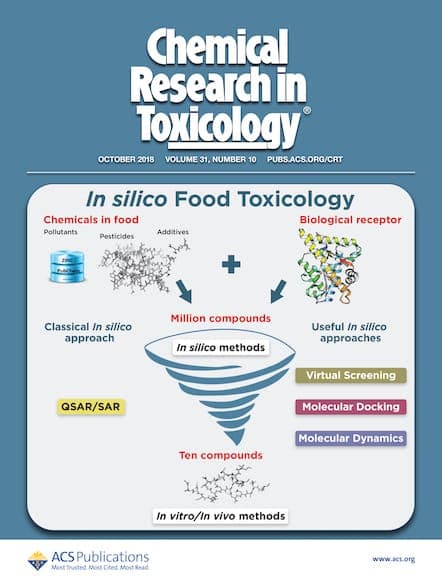The 2018 Chemical Research in Toxicology Young Investigator Award goes to Dr. Simon Wan Chan, Associate Profesor in the Department of Chemistry at The Hong Kong University of Science and Technology. He also received the 2017 Research Article of the Year Award Lectureship from the Journal of Agricultural and Food Chemistry and the ACS Division of Agrochemicals. […]

The 2018 Chemical Research in Toxicology Young Investigator Award goes to Dr. Simon Wan Chan, Associate Profesor in the Department of Chemistry at The Hong Kong University of Science and Technology. He also received the 2017 Research Article of the Year Award Lectureship from the Journal of Agricultural and Food Chemistry and the ACS Division of Agrochemicals. Dr. Chan will receive the award and deliver a lecture titled “Chemical approaches to investigate the toxicity of aristolochic acids” during the Chemical Research in ToxicologyYoung Investigator Award session on Tuesday afternoon at the Fall National Meeting in Boston.
Dr. Chan’s current research interest focuses on developing chromatographic and mass spectrometric methods. These methods can be used to identify and quantify toxic chemicals for food safety testing. They can also be used to study chemically/physically-induced damage to biological macromolecules such as DNA, RNA, etc. that is related to human diseases, and to investigate the biological consequence of external stimuli by using a systematic metabolomics approach.
“Dr. Chan has an extremely strong record of contributions in the area of environmental toxicology, including his work in delineating aristolochic acid exposure pathways, the implementation of protein biomarkers of exposure to formaldehyde and acetaldehyde, as well as the development of new bioanalytical chemistry approaches to address potential DNA damage arising from irradiation,” Professor Shana J. Sturla, Editor-in-Chief of Chemical Research in Toxicology.
Dr. Chan is a worthy recipient of the Chemical Research in Toxicology Young Investigator Award,” says Professor Thomas Spratt, Program Chair of the Division of Chemical Toxicology. “His research has focused on the chemical toxicology of food safety. His most important paper, (J. Agric. Food Chem., 64:5928−5934), was named the “Research Article of the Year” in the Journal of Agricultural and Food Chemistry. Through the work of Arthur Grollman and colleagues, we know that aristolochic acids are the cause of Balkan Endemic Neuropathy. Simon Chan showed that humans can be exposed to aristolochic acids directly through corn and wheat because these plants can absorb aristolochic acids from the soil. This work will impact strategies that we use to decrease exposure to these harmful environmental toxicants. However, my favorite manuscript is one he published in Chemical Research in Toxicology (Chem. Res. Toxicol. 29:1865-1871) in which he showed that formaldehyde reacts with cysteine residues to form a cyclic thia-proline residue. This modification alters the backbone structure of proteins because prolines exist in the cis-conformation. I will be looking forward to learning whether this modification does impact protein activity and whether cells utilize this modification as a surveillance system for formaldehyde-producing oxidants. He shows how careful analytical chemistry can be used to solve important medical problems
“As a postdoc with my group, Dr. Chan had wide-ranging and eclectic research interests — he was an engine for new ideas and new methods,” says Peter C. Dedon, the Underwood-Prescott Professor of Biological Engineering at the Massachusetts Institute of Technology. “As a member of the faculty at Hong Kong University of Science and Technology, he has now proven himself to be more than just a talented analytical chemist, with a long and diverse list of scientific accomplishments. More importantly, his work is having a true impact on public health policy. This is why he so deserves the Chemical Research in Toxicology Young Investigator Award.”
Other important Chemical Research in Toxicology articles by Dr.Simon Wan Chan include:
- Quantitation of the DNA Adduct of Semicarbazide in Organs of Semicarbazide-Treated Rats by Isotope-Dilution Liquid Chromatography–Tandem Mass Spectrometry: A Comparative Study with the RNA Adduct
Chem. Res. Toxicol., 2016, 29 (9), pp 1560–1564
DOI: 10.1021/acs.chemrestox.6b00232 - Identification of Protein Thiazolidination as a Novel Molecular Signature for Oxidative Stress and Formaldehyde Exposure
Chem. Res. Toxicol., 2016, 29 (11), pp 1865–1871
DOI: 10.1021/acs.chemrestox.6b00271 - Facile Formation of a DNA Adduct of Semicarbazide on Reaction with Apurinic/Apyrimidinic Sites in DNA
Chem. Res. Toxicol., 2016, 29 (5), pp 834–840
DOI: 10.1021/acs.chemrestox.6b00011
